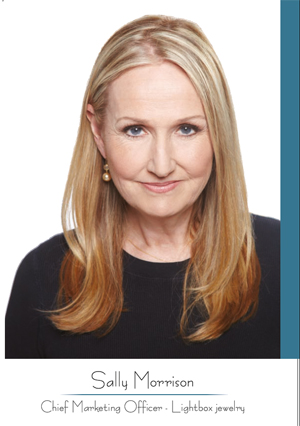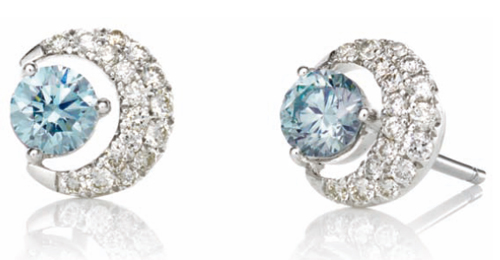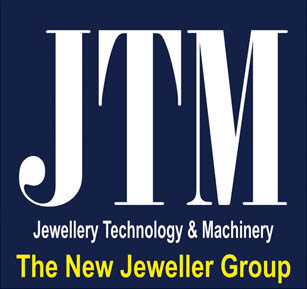
 De Beers caused ripples across the diamond jewelry world when it introduced its launch of Lightbox
jewelry set with lab-grown diamonds. The jewelry
line features pendant necklaces, stud earrings, bracelets and
stacking rings set with synthetic pink, blue and white
diamonds, priced uniformly at $800 per carat.
De Beers caused ripples across the diamond jewelry world when it introduced its launch of Lightbox
jewelry set with lab-grown diamonds. The jewelry
line features pendant necklaces, stud earrings, bracelets and
stacking rings set with synthetic pink, blue and white
diamonds, priced uniformly at $800 per carat.
Until recently, the range was only available for purchase via
the Lightbox website and retail ‘pop-ups. However, the
company recently announced that it would be teaming up with
Bloomingdale’s department stores and Reeds Jewelers for a
trial run of sales in bricks-and-mortar stores.
Chief Marketing Officer Sally Morrison explained the
thinking behind the jewelry and future plans in an interview
with Albert Robinson, The New Jeweller's Vice-President for
International Business.
It's been more than a year since the announcement of the
launch of Lightbox Jewelry, can you firstly give our readers a
reminder of the reasons why De Beers launched the brand?
Our research showed us that while there was significant
consumer confusion around the laboratory-grown category,
once consumers are clearly told what it is, they are interested
in this product for accessibly priced, fashion jewelry,
particularly in color. Lightbox was launched to provide
consumers with a brand that answered those needs. We are
especially excited about it because we feel that fashion jewelry
is a category that is ripe for growth.
De Beers CEO Bruce Cleaver said the idea was to tap into a new
market while pushing down the price of lab-grown diamonds in
order to force them into a different jewelry category. Has your
research shown that this is working?
It is still early days. What we can say is that, as we expected,
there is demand for an inventive brand, particularly in color, in
the fashion jewelry space. As an example, over the first year of
trading, pink and blue lab-grown diamonds have outsold the
traditional white stones. For nearly all consumers, this is
effectively a brand new product. Most people have never even seen a natural pink or blue!
Do buyers believe that Lightbox
stones are, as Cleaver has stated, just
fun objects and that when the time
comes younger buyers will be looking
for a real diamond when it comes to a
wedding ring?
That certainly has been our
experience. The vast majority of
consumers tell us that they prefer a
natural diamond for life’s milestone
moments. But they are open to
considering lab-grown for pretty,
decorative, jewelry, especially when
prices compare favorably with other
products in the competitive set -
designers handbags and shoes, for
example. So we believe there’s a real
opportunity to build an entirely new
space in jewelry.
Until recently, Lightbox stones have only been available for
purchase online but you announced a link-up with
Bloomingdale’s department stores and Reeds Jewelers in a
trial run. Can you explain why you decided to sell them in
bricks-and-mortar stores, and why specifically the
companies selected?
It was always our intention to test in brick and mortar stores
and we made that clear when we announced Lightbox. We
began by going directly to consumers to “pressure test”
interest in the brand. Further consumer learnings were
gained through a few pop-ups that we ran (in NY, LA, and
Miami).
These were tremendously important in gathering learnings
about the consumer response to the brand, and it allowed us
to refine some things, from our educational messaging
about the category all the way to our designs. Armed with
that, we felt ready to proceed with a limited brick and mortar
test which will allow us a deeper understanding of
consumer tastes. Bloomingdales and Reeds were selected
because they are trusted retailers, have a strong business in
fashion jewelry, and share our belief in the opportunity to
grow this part of the category.
Reports state that just 20,000 carats were being produced in
2019, while the new factory the company is building in
Oregon will enable the manufacture of hundreds of thousands of carats annually. Has
demand exceeded supply this year,
and does your research indicate that
the production of 200,000 carats
annually will be justified?
Currently our rough stones needs are
being met by Element Six in Ascot,
England. However, once the new
factory comes on stream next year in
Gresham, that plant will support the
requirements of the Lightbox brand.
Are tie-ups with brick-and-mortar
stores actually vital to the sale of such
a large production of stones? And will
we therefore see more such link-ups
in future months?
We start with the consumer. It is clear
that the modern consumer gathers
information all over: in store, on line,
from personal recommendations from their friends etc. In
order to be a relevant modern brand, we need to be
communicating - and available - wherever that consumer is.
It’s become clear that consumers want an omni-channel
experience from brands and they want to learn, and shop,
across multiple channels. So, in order to build a holistic and
successful brand, we believe we need to be available in
brick and mortar stores as well as online. Production is there
to support that, not vice-versa!
Can you give an indication of the type of buyer you are
seeing? Are they mostly younger buyers or a broader range?
We are seeing a very broad range of consumers shopping on
our site. There is no dominant demographic that has
emerged as yet.
What are colors that are currently being produced, and
which extra colors may be produced in the future?
Currently we offer pink and blue. However, our scientists
are at work on other colors, and we hope to offer more at
some point in the future.
How do you respond to the claims by some diamantaires that
Lightbox may affect demand for lower-quality natural
diamonds?
This is an entirely new product, and we believe it will be an
entirely new market, and help grow the fashion category.

